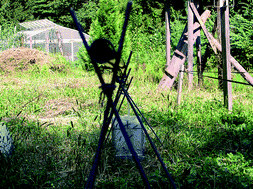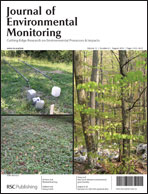Element fluxes through forest ecosystems are generally based on measurements of concentrations in soil solution at regular time intervals at plot locations sampled in a regular grid. Here we present spatially averaged annual element leaching fluxes in three Dutch forest monitoring plots using a new sampling strategy in which both sampling locations and sampling times are selected by probability sampling. Locations were selected by stratified random sampling with compact geographical blocks of equal surface area as strata. In each sampling round, six composite soil solution samples were collected, consisting of five aliquots, one per stratum. The plot-mean concentration was estimated by linear regression, so that the bias due to one or more strata being not represented in the composite samples is eliminated. The sampling times were selected in such a way that the cumulative precipitation surplus of the time interval between two consecutive sampling times was constant, using an estimated precipitation surplus averaged over the past 30 years. The spatially averaged annual leaching flux was estimated by using the modeled daily water flux as an ancillary variable. An important advantage of the new method is that the uncertainty in the estimated annual leaching fluxes due to spatial and temporal variation and resulting sampling errors can be quantified. Results of this new method were compared with the reference approach in which daily leaching fluxes were calculated by multiplying daily interpolated element concentrations with daily water fluxes and then aggregated to a year. Results show that the annual fluxes calculated with the reference method for the period 2003–2005, including all plots, elements and depths, lies only in 53% of the cases within the range of the average ±2 times the standard error of the new method. Despite the differences in results, both methods indicate comparable N retention and strong Al mobilization in all plots, with Al leaching being nearly equal to the leaching of SO4 and NO3 with fluxes expressed in molc ha−1 yr−1. This illustrates that Al release, which is the clearest signal of soil acidification, is mainly due to the external input of SO4 and NO3.

You have access to this article
 Please wait while we load your content...
Something went wrong. Try again?
Please wait while we load your content...
Something went wrong. Try again?


 Please wait while we load your content...
Please wait while we load your content...